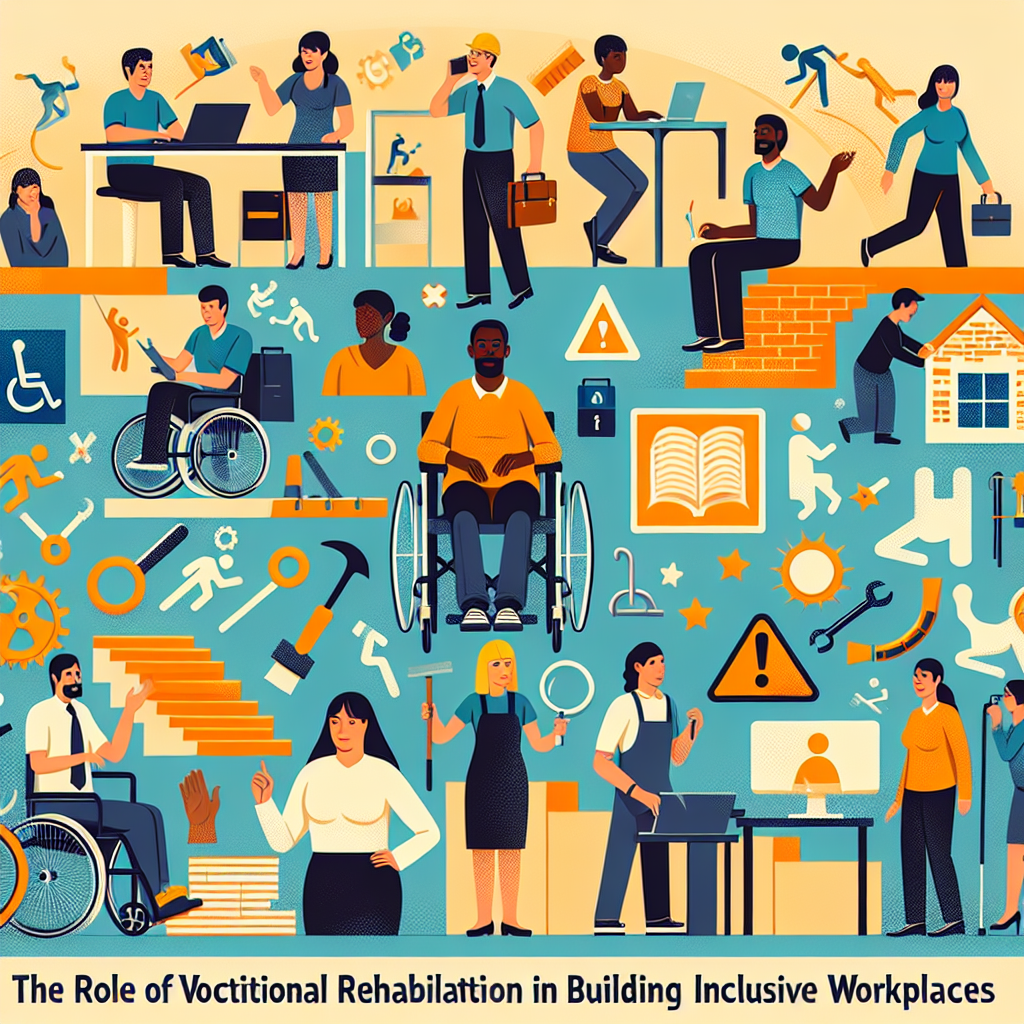
Introduction: The Path to Inclusion
In today’s diverse labor market, the importance of inclusivity cannot be overstated. Organizations are increasingly realizing that when they embrace diversity, they position themselves for greater innovation and success. Yet, how do we bring this diversity into the workplace? The answer lies in the role of vocational rehabilitation in building inclusive workplaces. This crucial component not only aids individuals with disabilities but also fosters a culture of acceptance, resilience, and collaborative success.
Understanding Vocational Rehabilitation
Vocational rehabilitation (VR) is a dynamic process that supports individuals with disabilities in gaining and maintaining meaningful employment. It encompasses a wide range of services designed to help individuals prepare for, find, and sustain employment among various industries. This ranges from career counseling and job training to adaptive technology and workplace accommodations.
You might wonder: why focus on vocational rehabilitation? The broader societal benefits, from enhanced employee morale to increased productivity, all point to a compelling case for why it matters.
Building the Foundation: Why Inclusivity Matters
The Business Case for Inclusivity
A diverse workforce is a tremendous asset. Research shows that companies with diverse teams are 35% more likely to outperform their competitors. The role of vocational rehabilitation in building inclusive workplaces goes beyond mere compliance with regulations; it actively enriches corporate culture and profitability.
| Statistic | Impact |
|---|---|
| 35% increase in performance | Financial benefits |
| 90% of consumers want to see diversity in advertisements | Marketing advantages |
| 2x increased innovation levels | Competitive edge |
The statistics speak for themselves. When company culture embraces all individuals, it leads to elevated employee satisfaction, increased retention rates, and enhanced community relations.
Meeting the Needs of All Employees
Varying needs require diverse approaches. The role of vocational rehabilitation in building inclusive workplaces involves not just hiring individuals with disabilities but ensuring that they thrive. This includes understanding the unique challenges they face and developing tailored strategies to address them.
Navigating the Challenges: Common Barriers
While the focus is often on the benefits of inclusivity, identifying the barriers is equally crucial. Common challenges include:
Awareness and Education: Many employers lack knowledge about available vocational rehabilitation services, leading to underutilization.
Stigma and Misconceptions: A negative perception about hiring individuals with disabilities exists, often rooted in unfounded fears.
Lack of Accessibility: Physical and technological barriers can hinder the integration of individuals with disabilities.
- Funding Limitations: Organizations may fear the costs associated with adapting the workplace for diverse needs.
By understanding these challenges, organizations can work towards solutions, transforming fears into empowerment.
Case Studies: Real-World Applications
Case Study 1: XYZ Tech Solutions
XYZ Tech Solutions, a mid-sized technology firm, partnered with a local vocational rehabilitation agency to develop a long-term training program for individuals with disabilities. The program included technical training, soft skills development, and mentorship initiatives.
Analysis: This partnership not only equipped individuals with necessary employability skills but also fostered a culture of acceptance within the company. Employees reported higher job satisfaction and engagement levels during the program, showcasing the role of vocational rehabilitation in building inclusive workplaces.
Case Study 2: ABC Manufacturing
In a bid to foster inclusivity, ABC Manufacturing implemented an accessibility audit. With the help of vocational rehabilitation experts, they modified workstations, introduced adaptive technology, and reorganized work processes.
Analysis: Post-implementation, the company saw a 15% increase in productivity and a 20% reduction in turnover. Employees felt valued and supported, confirming that inclusivity leads to tangible business results.
Case Study 3: DEF Retail
DEF Retail’s commitment to inclusion became evident when they dedicated resources to vocational rehabilitation initiatives. They actively recruited from local rehabilitation agencies and provided ongoing training.
Analysis: The diverse input from a variety of perspectives only enriched the company’s culture, leading to increased creativity in marketing campaigns that successfully reached underrepresented demographics.
Strategies for Implementing Vocational Rehabilitation
Connect with Local Agencies: Collaborate with vocational rehabilitation services to identify candidates and appropriate training programs.
Create Inclusive Policies: Draft clear policies that emphasize the organization’s commitment to inclusivity and the support offered to individuals with disabilities.
Training for Staff: Conduct training sessions to educate employees on the importance of inclusivity and the specific accommodations available.
Technology and Workplace Adaptations: Invest in assistive technology that can make a significant difference in productivity and job satisfaction for employees.
- Encourage Open Dialogue: Create a workplace culture that encourages feedback and open discussions about inclusivity and accommodations.
The Role of Leadership in Fostering Inclusivity
Leadership plays a vital role in establishing an inclusive workplace. By taking actionable steps, leaders can set the tone:
Visibility and Accountability: Leaders should publicly commit to diversity and inclusion goals and hold the organization accountable for progress.
Mentorship Opportunities: Encouraging mentorship programs can pair experienced employees with those entering the workforce through vocational rehabilitation channels.
- Celebrating Diversity: Organizing events that celebrate diversity and promote inclusion fosters community spirit and reinforces an inclusive workplace identity.
Measuring Success
Metrics to Track Progress
To assess the impact of initiatives related to the role of vocational rehabilitation in building inclusive workplaces, utilize the following metrics:
| Metric | Description |
|---|---|
| Employee Satisfaction Surveys | Regularly gauge employee feelings regarding inclusivity and support. |
| Retention Rates | Evaluate if inclusive practices enhance retention of diverse employees. |
| Productivity Levels | Measure changes in productivity pre- and post-implementation of initiatives. |
| Recruitment Metrics | Track how many candidates with disabilities are employed over time. |
Setting benchmark goals and reviewing progress regularly allows organizations to refine their approaches and adapt to evolving needs.
Conclusion: The Future of Work is Inclusive
The journey toward inclusive workplaces is ongoing, but the significance of the role of vocational rehabilitation in building inclusive workplaces cannot be underestimated. It requires not only effort from organizations but also engagement with communities and advocacy for policies that support inclusivity.
As you reflect on the role you play within your organization, consider the transformative power of vocational rehabilitation. When we rise to the occasion to incorporate diverse talents, we not only strengthen our commitment to inclusivity but also empower individuals—fostering an environment where everyone can thrive.
FAQs
What is vocational rehabilitation?
Vocational rehabilitation is a set of services aimed at helping individuals with disabilities gain skills, find employment, and maintain their jobs.How does vocational rehabilitation promote inclusivity?
By providing tailored services and support, vocational rehabilitation makes it possible for individuals with disabilities to enter and thrive in the workforce.What are some common services offered by vocational rehabilitation programs?
Services often include job training, counseling, assistive technology support, and workplace accommodations.How can companies fund vocational rehabilitation initiatives?
Companies can seek grants, collaborate with agencies, or allocate specific budgets aimed at inclusivity and accessibility.- Why should organizations invest in inclusive practices?
Investing in inclusive practices leads to enhanced employee morale, increased innovation, and better overall business performance.
By embedding vocational rehabilitation into the core of workplace culture, you’ll not only create a more inclusive environment but also establish a thriving, diverse workforce that propels your organization into the future. Remember, fostering inclusion is not just beneficial—it’s essential.
















